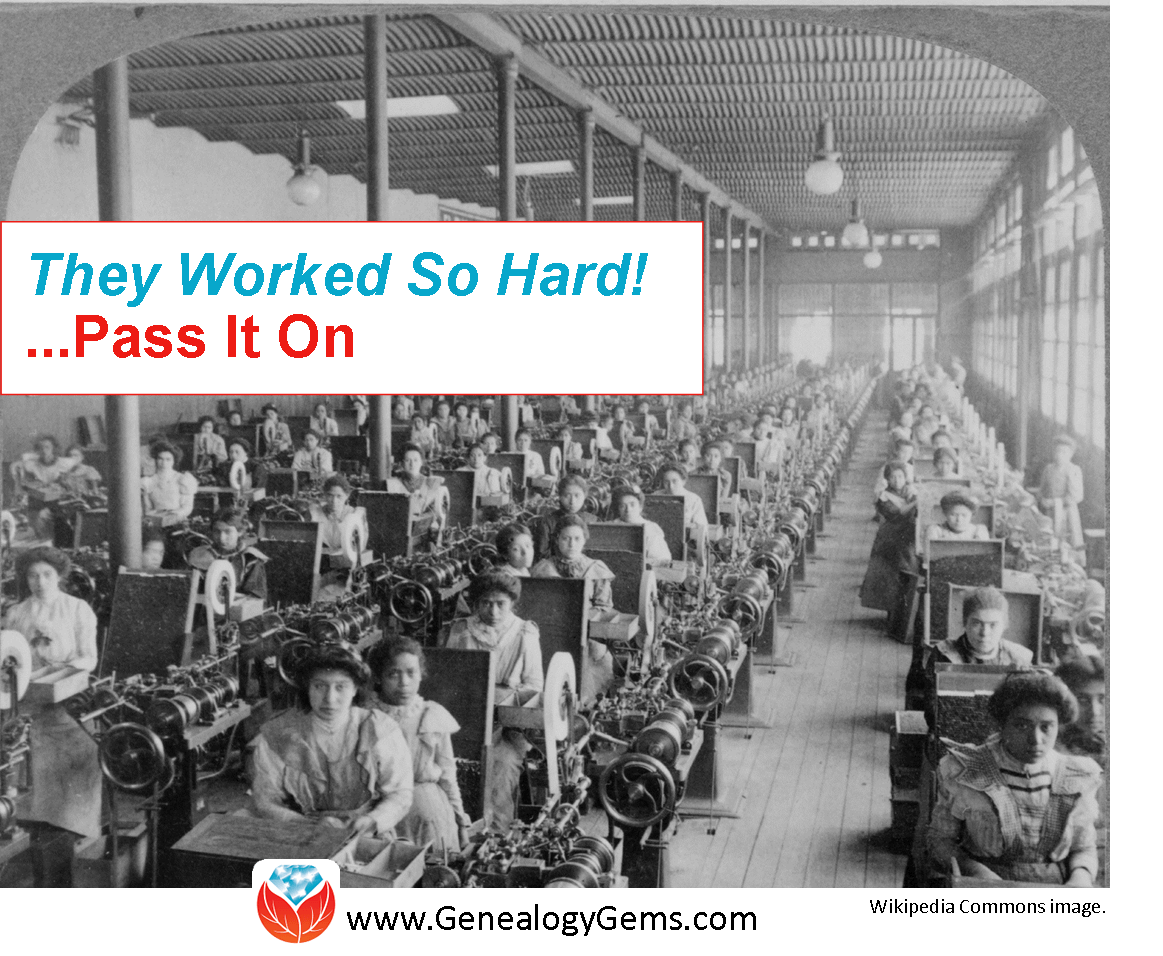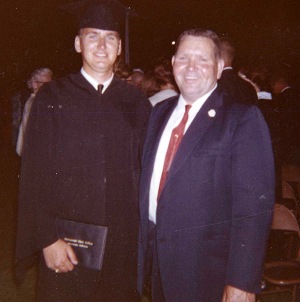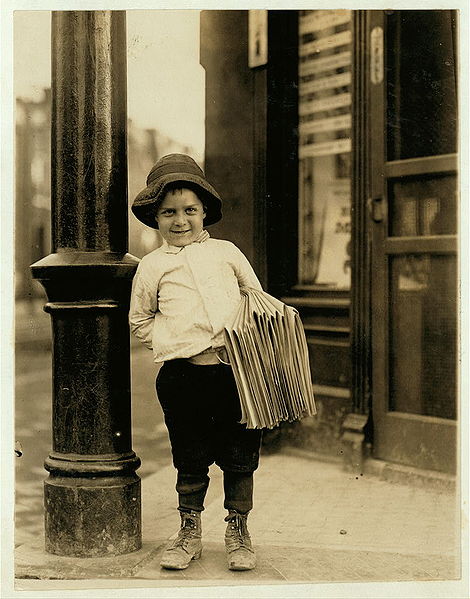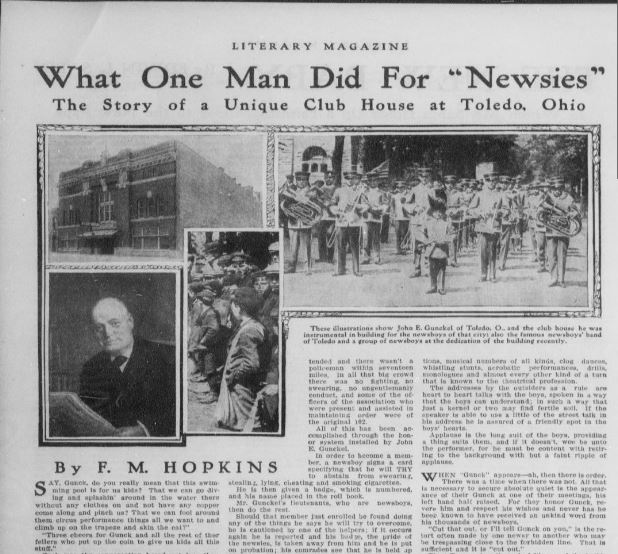by Lisa Cooke | Aug 30, 2019 | 01 What's New, Holidays, Inspiration

Back in 2013 a YouTube video went viral about the importance of hard word and making your own luck, values I am fortunate that my ancestors passed on to me. The speech came from an unlikely source: a young Hollywood actor. In the video, Ashton Kutcher stands in front of a bunch of teenagers at the Teen Choice Awards talking about the importance of hard work:
“When I was 13, I had my first job with my dad carrying shingles up to the roof, and then I got a job washing dishes at a restaurant, and then I got a job in a grocery store deli, and then I got a job at a factory sweeping Cheerio dust off the ground,” Kutcher said.
“And I’ve never had a job in my life that I was better than. I was always just lucky to have a job. And every job I had was a stepping stone to my next job, and I never quit my job until I had my next job. And so opportunities look a lot like work.”
As I said, this video went wildly viral (which is how I came across it) and it got me to thinking about my own work ethic. The credit for it sits squarely on my dad’s shoulders, and also my grandparents shoulders, and their grandparents shoulders.
My dad was the first in his family to get a college degree. (image above: Dad and my proud Grandpa at Dad’s Graduation) He went to school and studied all day and worked in the local hospital morgue at night!
I remember endless nights as a kid creeping up behind him as he sat in at the makeshift office in my parent’s master bedroom, puffing on a pipe and studying for his CPA. We didn’t have much in common to talk about, but it was what I saw in action that was communicating to me. Dad went on to become a successful businessman in a large company, and later created several vibrant businesses.
Getting the Message
I guess it was that non-verbal communication between father and daughter that inspired me as a kid to pull weeds, babysit and yes even shingle the side of the garage to make a few bucks.
And I vividly remember taking a temporary job caring for a 100 old year woman for a few weeks one summer. She was testy at first as she felt generally ignored, but warmed up to her inquisitive caregiver until she was soon sharing stories of traveling as a little girl in a covered wagon. She’d found her audience and I was entranced.
At 15 I lied about my age so I could get a job at pizza place washing dishes. Within two days they promoted me to cook, a position a girl had never held in that restaurant.
Later I went on to my teenage dream job – sales clerk at the record store at the mall. (Sheer persistence helped me beat out all the other teens for that one!)
And then, on to a job at Radio Shack (this time the first female to be hired in the state to the best of my knowledge) as the TRS-80 computer hit the shelves.
I started my professional career working for free at a travel agency to get a little resume cred as I finished travel agent school, and was the first to land a job a week before graduation. I went on to working in corporate America where I received invaluable career development.

Signing books with my grandsons.
An Entrepreneur at Heart
But like my dad, I’m an entrepreneur at heart. I’ve created a couple of businesses and positions for myself over the years, and find myself now with Genealogy Gems living my dream and drawing from all of my past experiences.
There have been many challenges along the way – no one ever said work was easy. In fact, my mom’s favorite saying that was drilled in to us as kids was “life isn’t fair – get over it!” She was absolutely right, and she removed the obstacle of fretting over fairness from my life, so I could just get on with working hard and creating my own dreams. I was one lucky kid!
Now whenever a challenge arises, my instinct is to say to myself: I can’t wait to find out what future opportunity this dilemma is training me for!” Almost without exception, I can look back over my past work experiences and see how they are helping me today. Some of the very worst have turned out to be blessings.
(Update: I talk more about this and my career in an interview I did on the Genealogy Professional Podcast Episode 29.)
The Good News About Your Family Tree
Even if the most recent generations that came before you let you down or hurt you, family history offers you centuries to pull new and positive values from.
Your ancestors were survivors and yep, that’s why you’re here! You may have parents or grandparents who went astray, but you have countless ancestors to find, and learn from.
Best of all, you get to pick which values you wish to embrace, and which will fall by the wayside.
Let us pass on what our ancestors taught us so our kids and grand kids can enjoy the opportunities, growth, reward and freedom that comes from good old hard work.
Lucky Opportunities
So what “lucky” opportunities have you had and created?
On this Labor Day I hope you’ll join me in the comments below and share what you learned about work from your previous generations.
Why not share this post with someone YOU know who works hard? Let them know how much you admire them.

by Lisa Cooke | Sep 8, 2015 | 01 What's New, Book Club, Craft & Displays, images, Listeners & Readers, Records & databases, Writing Family History
 Since featuring Pioneer Girl in the Genealogy Gems Book Club, so many Little House gems have surfaced that we wanted to share this patchwork of Laura Ingalls Wilder documents and stories with you.
Since featuring Pioneer Girl in the Genealogy Gems Book Club, so many Little House gems have surfaced that we wanted to share this patchwork of Laura Ingalls Wilder documents and stories with you.
The Wilder Homestead Claim
A year before he married Laura Ingalls, Almanzo Wilder proved (or secured) his homestead claim to a tract of land he had been steadily improving in Dakota Territory. Click here to read an article about Almanzo’s claim and see a copy of the document. (Find federal land claims for much of the Midwest and West at the Bureau of Land Management General Land Office Records website. Genealogy Gems Premium members can learn more about the Homestead Acts and land claims that may have been filed by their ancestors in Genealogy Gems Premium podcast #33.
Little House-Inspired Fabric Series
Thank you to Barbara from NY who wrote in to say, “Lisa, I know you are very crafty so I wanted to let you know about a new fabric line that is coming in the fall. Andover Fabrics is putting out the Little House on the Prairie fabric line. In their ad it gives a quote from the book, “The attic and the cellar were full of good things once more and Laura and Mary had started to make patchwork quilts. Everything was beginning to be snug and cosy again.” I thought this went well with the book club book for this month.” Thank you, Barbara! We’ll have to look for some heritage projects that will theme well with these fabrics!
Writing and Editing the Little House Series: A Mother-Daughter Effort
Laura Ingalls Wilder’s Little House series didn’t come to press until decades after her childhood. By that time, her daughter Rose Wilder Lane was a freelance writer who knew the market. She saw the value in her mother’s memoirs and wanted to help her shape them into marketable books. This article talks about how stormy their collaboration could be, as they haggled over how best to memorialize Laura’s memories for modern children.
We heard from Chris on the subject of Rose’s editorship. “I also read Pioneer Girl and frankly enjoyed it a lot,” Chris says. But Chris has always wished Rose got more credit for the extensive editing and rewriting she did for her mother’s work, which apparently remained largely unknown. “As genealogists, we want to give all credit where it is due.” She recommends that Little House fans read A Wilder Rose by Susan Wittig Albert, which tells Rose’s story. Knowing Rose’s role doesn’t diminish Chris’ love for the Little House books, just gives her added perspective on the story-telling behind the stories.
Anyone who has ever tried to write a life story (their own or someone else’s) in a format for others to read will be fascinated by the letter shown in that article. Rose is trying to convince her mother of the need to whittle down her stories to the strongest story lines. “It is beyond all human power to tell all the facts. Your whole lifetime spent at nothing else would not tell all the facts of one morning in your life, just any ordinary morning when you get up, dress, get breakfast and wash the dishes.”
Resources
The Genealogy Gems Book Club Selects Pioneer Girl as Featured Book
Interview with Editor of Pioneer Girl: Laura Ingalls Wilder (This is an excerpt from the full interview, which will run in an upcoming Genealogy Gems Premium podcast episode.)
How to Reconstruct Your Early Childhood Memories and Stories
Genealogy Gems Premium Podcast Episode 116 for Life Story Writing Tips with Laura Hedgecock, author of Memories of Me: A Complete Guide to Telling and Sharing the Stories of Your Life (Premium membership required to access)
 The Genealogy Gems Book Club brings you great titles like Pioneer Girl, along with exclusive conversations with the authors. We’ve featured best-selling novels and memoirs, nonfiction books like this one and less-discovered titles we love. Click here to see other books we’ve featured and listen to the author interviews.
The Genealogy Gems Book Club brings you great titles like Pioneer Girl, along with exclusive conversations with the authors. We’ve featured best-selling novels and memoirs, nonfiction books like this one and less-discovered titles we love. Click here to see other books we’ve featured and listen to the author interviews.
Who else do you know who might enjoy the Genealogy Gems Book Club? Please share it with them?
by Diahan Southard | Sep 26, 2014 | 01 What's New, Collaborate, Photographs, Trees
 Recently we heard from Julie who listens to the podcast overseas. She is weighing the pros and cons of having her online family tree be private or public. Public trees can be searched and viewed by the general public and/or other members of that particular website. Private trees are just that. They are generally only searchable and viewable by individuals who have been invited to see them by the owner.
Recently we heard from Julie who listens to the podcast overseas. She is weighing the pros and cons of having her online family tree be private or public. Public trees can be searched and viewed by the general public and/or other members of that particular website. Private trees are just that. They are generally only searchable and viewable by individuals who have been invited to see them by the owner.
Julie shares some great observations about what it’s like to work with other tree owners and how it feels when information is freely taken from her–but there is no sharing in return.
On working with other people’s public trees:
“If it wasn’t for [other people’s] trees being public–even the ones with sketchy information–I would not have made contact with distant cousins or made many of the discoveries I have. Some of the dodgy information has helped me to improve my search and analytical skills and I always contact the owner if I have found something that doesn’t ring true (hopefully diplomatically!). Most of the time the tree owners are grateful and we then exchange more information.
When information is copied from my tree I will often contact the person to see how we are related and to see if we might be able to collaborate some more. (I don’t post everything I have on my online databases.) If I get no response it does leave me feeling uncomfortable (especially when it is photos) about having posted the info and it being taken without any communication. I do also contact tree owners when I copy photos or documents, even if it is just to say thank you. Maybe it is because photos are that much more personal.”
On working with private tree owners:
“I find it even more frustrating when someone with a private tree copies things from my public tree without making any contact. This is then exacerbated if I contact them and they don’t respond. Maybe I’m being unreasonable – or maybe I’m missing something. It comes across to me that they are willing to take but not that willing to share. One person I did contact who responded very kindly shared some information with me but was very blunt about the fact they did not want to see any of the information they provided on the internet, yet they had happily taken some of the documents/photo’s I had posted. I found that interesting.”
So…private or public?
“I am now feeling unsure about which is the best way to go as I can see pros and cons about both. In the meantime I have stopped adding media to my online tree, and I’m considering removing some of what I have posted and instead include a note saying if you want the document/photo please contact me. However, I am not convinced about this as I love it when I find photos/documents on other trees.”
 Family Tree Etiquette:
Family Tree Etiquette:
I do wish for a more communal genealogy world, in which information is shared freely and all branches of a family tree intertwine themselves in love. Of course that’s not how things are. But I feel like every person who “puts things out there” brings us closer to that ideal.
That said, I admit I’ve copied photos and documents from other people’s trees in the past without contacting them. I didn’t mean to be rude. It just didn’t occur to me to contact them, especially if they clearly weren’t closely related and I had no immediate questions about their sources. But you’re right. Photos feel more personal. In the future I hope I will always remember to send a “thank you” message whenever I snag someone’s images for my tree.
I appreciate Julie’s compromise: she keeps a public presence but encourages others to be respectful and communicative by telling them to contact her for images. You’d likely have to look closely at her tree to find those messages from her, which will reward the most intrepid researchers. Beginning or more casual researchers might miss her invitation and therefore an opportunity to collaborate.
For everyone, whether to post a private v. public tree comes down to our priorities. Do we most want to meet distant relatives? Collaborate with other branches of the family to learn the most possible about our shared past? If so, public trees are the way to go. If personal or family privacy is paramount (especially if your tree holds family secrets that aren’t ready to share), or the research is still very tentative, make it a private tree.
You may even split things up: have public trees when you’re reaching out to others and private ones when you’re not. Lisa says if she had to do it all over again, she would not upload her entire tree but just the “trunk,” or her direct-line ancestors. (Lisa always keeps her master tree on her home computer, not in online genealogy databases over which she has no control.)
Whether your own trees are public or private, Julie’s thoughts are a good reminder about using our best manners when communicating with other tree owners. Here at Genealogy Gems, we do believe in the value of collaborating on your genealogy. In fact, we ran a series of posts on how to collaborate. Check out the first one here! And we have a brand new free video on using the free program Evernote to share your sources.
by Lisa Cooke | Nov 6, 2013 | 01 What's New, History, Newspaper
Newsboys or “newsies” used to sell the news. But for a time in American history, they were the news!

Newsboy. Little Fattie. Less than 40 inches high, 6 years old. Been at it one year. May 9th, 1910. Location: St. Louis, Missouri. Wikimedia Commons image, original at Library of Congress.
You’d know them by their common call: “Read all about it!” It was their job to sell stacks of inexpensive newspapers on every street corner that would support them. The Library of Congress has posted a fascinating page about the history of newsies, including their own appearance in the papers.
In 1899, newspaper prices rose–and that cut into the profit margins of boys who had very little profit to begin with. In New York City, many newsboys refused to sell papers published by Pulitzer and Hearst. Over the next few years, the newsboys didn’t exactly unionize, but they did organize. Eventually they formed the National Newsboys’ Association, which evolved into today’s Boys Club and Girls Club.
It’s interesting to read how the newspapers reported the doings of the boys who were essentially their salespeople. I bet it was a tricky place to be caught: a newspaper couldn’t afford to totally alienate their own best salesmen. Those salesmen were actually children, whom nobody wants to be accused of targeting. But their activities were aimed at driving down prices. In some cases, you see newspapers taking “the high road” and reporting charitable efforts to help these boys, like this story from the 1909 Washington Herald:

Click here to read this full story on Chronicling America. And click here to “read all about” newsboys and their role in American newspaper life.

Remember, stories like these are the kind that shaped our ancestors’ lives. Whether we find our relatives mentioned directly in the paper or we just see what life was like around them, we can learn so much from reading the same newspapers they did. Learn more from my book How to Find Your Family History in Newspapers–and Genealogy Gems Premium Subscribers can check out “Getting the Scoop on Your Ancestors in Newspapers” in the Premium Videos section.
by Lisa Cooke | Aug 25, 2015 | 01 What's New, Cloud Backup, Disaster Prevention, images, Inspiration, Listeners & Readers, Preservation, Publishing, Writing Family History
 It’s time (maybe past time!) to write your family history. Should you write a book or throw everything into a digital archive?
It’s time (maybe past time!) to write your family history. Should you write a book or throw everything into a digital archive?
Recently Joyce attended a genealogy conference I taught that was sponsored by the Central Arkansas Library System. She wrote to us that she went home with a newly-resolved plan for how to write her family history:
“I thoroughly enjoyed hearing you speak. I learned a lot also. There was a question asked at the conference that I had also thought a lot about: how to leave your legacy to your family. With technology changing every day, I have decided that the old-fashioned way is probably the best. Technology will not change the fact that we can sit down to a paper book. So I will keep my CDs, DVDs, and flash drives; however, I will print out books for my family to have, whether they have access to the computer or not.”
A Combination Approach
I certainly agree that paper and books are certainly a solution for genealogical information being accessible for generations to come. I like a combination approach. Since paper can deteriorate and become damaged like anything else, having a cloud back up service (I use Backblaze) and digital items like flash drives is also a good plan.
Part of leaving a legacy also involves finding ways to share that help the next generations (particularly those not interested in research) understand the value of the family tree. That’s where a Google Earth “family history tour” or other innovative sharing comes into play. If you can click click, copy, and paste, you can create an exciting multi-media story that looks like a video game that will captivate the next generation! (Learn how to create a Google Earth family history tour in my 2-volume Google Earth for Genealogy CD). The combination of sharing the info in fascinating ways and preserving the info in reliable multiple formats is a comprehensive strategy for the future!
Resources
How Cloud Backup Helped One Genealogy Gem Get Closer to Living a Paper-Free Life
Recommended File Formats for Long-Term Digital Preservation
Why I Use and Recommend Backblaze Cloud-based Computer Backup Service
 Ready to make your own plan to write your family history and preserve it digitally? Share your resolve–along with this post–with someone else! Use the handy icons at the top of the page to share on Facebook, Pinterest or your favorite social media site, or email the link to this article to a friend. Thanks!
Ready to make your own plan to write your family history and preserve it digitally? Share your resolve–along with this post–with someone else! Use the handy icons at the top of the page to share on Facebook, Pinterest or your favorite social media site, or email the link to this article to a friend. Thanks!













